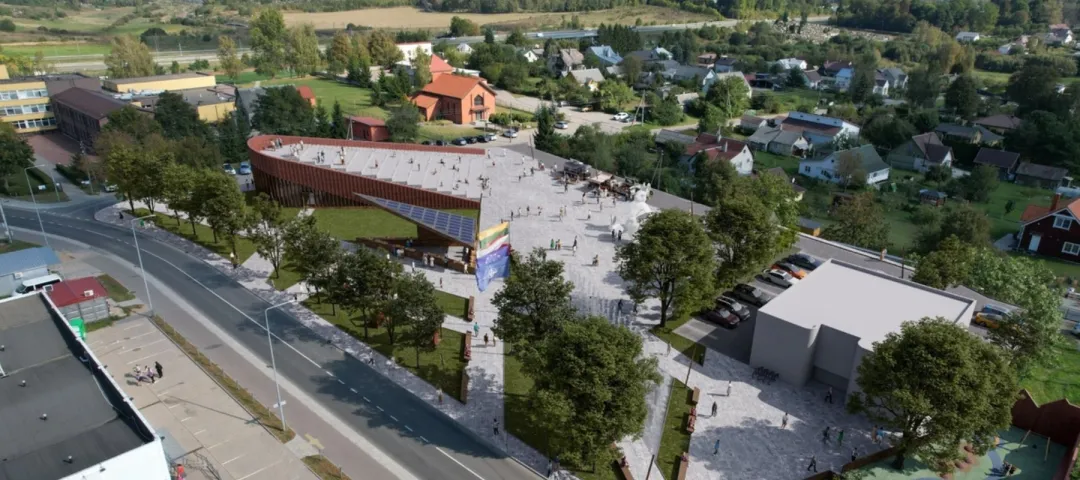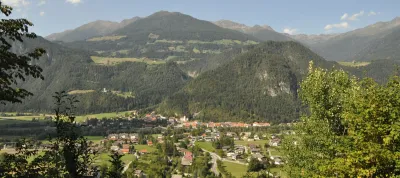Smart Villages in Lithuania: innovations for rural future
Lithuania’s journey towards smarter and more resilient rural communities is gaining momentum with the introduction of the Smart Villages (SV) in the Lithuanian CAP Strategic Plan (CSP).
Lithuania’s journey towards smarter and more resilient rural communities is gaining momentum with the introduction of the Smart Villages (SV) in the Lithuanian CAP Strategic Plan (CSP).
A distinctive approach to rural development
The SV initiative is implemented as a stand-alone Smart Villages intervention (KP21sum intervention) under the Lithuanian CSP, using the knowledge learnt from and principles of LEADER. It complements the LEADER approach and plays an important role in achieving Priority 3 of the Lithuanian CSP: "Building vibrant, farming and business friendly villages “.1
“The SV uses the same basic LEADER approaches, notably the bottom-up principle, support for local initiatives, partnership and territorial approach,” explains Jelena Dokudovič, Senior Specialist at the Ministry of Agriculture's LEADER Programme and Rural Development Division. “This allows the instrument to remain closely linked to community development and local self-government, but at the same time provides more opportunities to integrate cross-cutting projects into a coherent Smart Rural Strategy (SRS).”
Under this model, Local Action Groups (LAGs), in cooperation with local stakeholders, can develop an SRS - an umbrella initiative coordinating a number of interlinked projects to address specific territorial issues. The SRS is developed in an integrated manner, with investment projects developed by the project promoters. The LAGs actively involve local communities in the overall development of the strategy, submitting single applications and coordinating the whole implementation and monitoring process. Strategies can be developed not only along administrative boundaries, but also by functional areas, which makes it possible to address problems, such as the fragmentation of small villages or the lack of services, more effectively.

Building the foundation: preparatory work
The groundwork for SV in Lithuania was extensive and collaborative. In 2021, the Ministry of Agriculture commissioned a national study on the concept of SV, led by Vytautas Magnus University, which developed the national model and implementation guidelines. The National Rural Network (NRN), LAG Network, and Lithuanian Rural Communities Union played key roles in stakeholder engagement, hosting thematic workshops, consultations and capacity-building events across all counties.
These events were important in disseminating information about the initiative itself, helping stakeholders understand the Smart Village model, its objectives and opportunities. The events also stimulated stakeholder discussions, which helped develop ideas and build common understanding. One of our biggest challenges was distinguishing Smart Village projects from traditional LEADER local projects, basic services and infrastructure projects. It was important to ensure that the SV intervention had its own added value. We realised that a wide network of partnerships (e.g. between sectors, LAGs, and local project promoters at local level), cross-sectoral collaboration, and territorial concentration on problem-solving are the key distinguishing features of successful Smart Village projects.
Indeed, SV projects are consistently oriented towards achieving common goals, and have a unified focus on solving a specific targeted problem, rather than operating as separate, independent projects, as is generally the case with LEADER projects (where funding is allocated to individual local projects based on the local development strategy, and projects are not always coordinated towards a common goal).
The bottom-up principle and a change-oriented mindset are other distinctive features of the Smart Village approach in Lithuania. As Kristina Švedaitė, Chair of Kaunas District LAG and the Lithuanian LAG Network, emphasises in her interview.
Pilot projects and first results
In 2023, the calls for the submission of pilot SV projects started in the selected rural LAGs (under the Rural Development Programmes). 15 out of 49 rural LAGs have received additional funding for pilot SV projects.
One notable example is the Kaišiadorys District LAG. This SV project created a ‘smart service space’ in Rumšiškės that features two mobile hubs dedicated respectively to radio (and podcast) production and broadcasting, and to citizen consultations (where residents can ask for advice on issues such as applying for heating compensation, filling out documents, or how to contact relevant institutions). In addition, a freely accessible ‘smart power spot’ allows users to charge their phones, stream music and use the Internet. The project also created the e-shop e-korys.lt, exclusively dedicated to local products and services from the district, which helps strengthen the local economy and improves residents' access to local services and products.
The experience from Pajūrio kraštas LAG echoes the value of piloting the SV project ‘Smart Rural Innovation Centre Brožiai’. The Centre Brožiai acts as a hub for sustainable food production, education and community innovation, fostering short food supply chains, expert training and cross-sector collaboration. Its benefits include stronger community ties, economic revitalisation through job creation, and a sustainable model for rural development, positioning Brožiai as a pioneering example of a Smart Village in Lithuania.

Kaunas and Vilnius districts: pioneering Smart Village strategies (SVS)
By 2024, Lithuania moved to full-scale implementation of Smart Villages through the CAP Strategic Plan. Kaunas District LAG and Vilnius District LAG were the first to have their strategies approved, with five more strategies reaching the evaluation stage in 2025.
Vilnius District LAG strategy ‘Dynamic Business and Social Innovation Hub’ focuses on addressing social, economic, and environmental challenges through job creation and employment enhancement, social inclusion activities, infrastructure improvements and education and community activities. For example, two of the five projects, ‘Entrepreneurship and Social Innovation Centre’ and ‘Multifunctional Entrepreneurship and Social Innovation Space’, have been designed to provide modern spaces for remote work, skills development, and community collaboration.
These projects aim to create a more active, united and conscious community that contributes to the social, economic and ecological development of Vilnius district, thus directly improving residents' quality of life and well-being. As the territory is close and well-connected to Vilnius, the strategy directly benefits about 13 000 residents, but its impact is likely to extend well beyond the local area.

Kaunas District LAG’s strategy ‘Sustainable Initiative Spaces’ promotes environmental sustainability, digital inclusion and youth engagement. It focuses on smart public spaces and digital solutions that enhance rural life and entrepreneurship. With a budget of less than EUR 700 000, the strategy involves more than 13 400 residents, and emphasises strong local partnerships and active community participation. Nearly all the residents benefit from improved infrastructure and services, such as the Smart Park in Noreikiškės and the Sustainability Space in Kluoniškiai, enhancing daily life, public spaces, and access to community facilities. On the other hand, residents are actively involved in shaping and implementing projects through a bottom-up approach, contributing ideas, participating in planning, and engaging in events such as festivals, workshops, and youth programmes. Thus, the strategy ensures that residents are both beneficiaries and active contributors, helping create a more sustainable and inclusive rural community through participation and shared responsibility.
This shift towards visible, locally relevant outcomes is changing the way rural people perceive EU support. As Kristina Švedaitė notes:
We clearly see a positive change. In the past, EU support was often perceived as distant or oriented only towards farmers. Now that LEADER and Smart Village projects are touching everyday life- public spaces, services, community involvement- people are much more interested and involved. EU support is an essential tool for modernising rural areas, promoting innovation and social inclusion.
Community involvement and communication
Communication is a key element of SV. Both Kaunas and Vilnius districts' LAG strategies emphasise inclusive communication and the involvement of residents through regular information meetings, public events, workshops and youth activities. Kaunas district has a dedicated sustainability ambassador and youth media initiatives, such as a mobile video studio. Vilnius District (officially considered a rural area) will use a digital innovation platform and extensive outreach tools to reach the community. These efforts demonstrate a commitment to transparency, local empowerment and continuous dialogue with residents.
Funding and Territorial Scope
The total budget of SVs in Lithuania is EUR 15 million in public expenditure, with funding distributed as follows among the participating LAGs:
- EUR 500 000 for SV strategies covering a single LAG territory.
- EUR 600 000 for those covering two LAGs’ territories.
- EUR 700 000 for strategies covering three or more LAGs or territories with over 40 000 inhabitants.
This tiered approach encourages cooperation and recognises the needs of larger territories. SVS are currently implemented in Central and Eastern Lithuania across diverse municipalities and LAG territories. The initiative creates functional zones beyond administrative boundaries, allowing for effective solutions to the problems of scattered villages and service provision.
The SV initiative demonstrates the EU's commitment to rural prosperity and inclusive growth. The approval of more strategies by 2027 will broaden both the territorial and population coverage, making EU investments more visible and meaningful for rural communities.
Find out more
Basic information about Smart Villages in Lithuania is summarised in the CAP analysis carried out by the Smart Rural 27 initiative, which also presented Lithuania as one of its ‘lighthouse examples'.
The EU CAP Network website offers key information about the CAP Strategic Plan in Lithuania, the National Network and the list of active LAGs in the country.
Useful documents available in the national language (besides those linked in the article) include Lithuania’s Agriculture and Rural Development Strategic Plan 2023-2027 and the Guidelines for the Implementation of Smart Villages Projects.
Footnote 1:
The Lithuanian Strategic Plan identifies four main priorities:
- Priority I: Ensuring the supply of sustainably produced agricultural products, increasing the sector's added value and competitiveness.
- Priority II: Adaptation to climate change and protection of natural resources.
- Priority III: Creating a vibrant and attractive countryside for farming and business.
- Horizontal priority: Knowledge sharing and focus on innovation - modernising the sector by promoting knowledge, innovation and digitalisation in agriculture and rural areas and sharing them, as well as encouraging their implementation.
